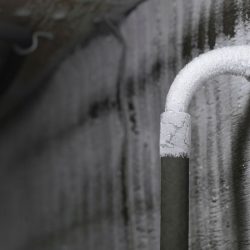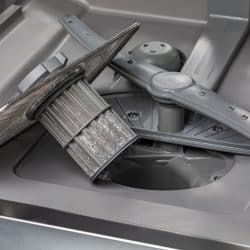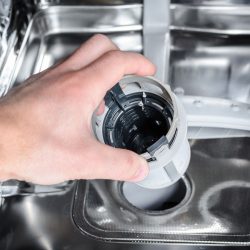Winterizing your dishwasher may not be something that you think of very often, or at all. When you think of winterizing an appliance, more often than not, it's an air conditioner, water heater, or refrigerator. The truth is that any household appliance that contains drains should be winterized if they will be subjected to extremely cold weather. This post will cover how to winterize your dishwasher and the best time to do it.
Winterizing your dishwasher can prevent it from freezing if exposed to below-freezing temperatures. If your dishwasher freezes, the pipes can burst and cause a huge mess and expensive repair in your home. Such scenarios can occur if your dishwasher is located in a vacation or rental home unoccupied during winter. It might also be necessary to remove your dishwasher and place it in a storage unit or the garage.
Winterizing By Drainage
- Prep The Dishwasher
- Disconnect The Water Supply
- Remove And Clean The Filters
- Clean The Sump Pit
- Clear The Water Drain Line
- Clear The Drain Valve
Winterizing Using Antifreeze
- Drain The Dishwasher & Add Anti-freeze
- Turn it Off Before The Rinse
- Rinse Out The Anti-freeze Before Future Use
The best time to winterize your dishwasher is before any event where the dishwasher will be left for an extended period of time in weather that may drop near or below freezing. Continue reading to learn about the steps involved with each dishwasher winterization process.

How To Winterize Your Dishwasher
1. Prep The Dishwasher
Open up your dishwasher and remove any dishes and silverware that may be inside. Also, check the detergent dispenser to make sure that no liquid or powder detergent is inside. Remove the silverware basket and the top and bottom dish racks and set them in a nearby closet or the pantry. Next, wipe down the interior of your dishwasher with a damp rag and cleaning solution (or you can simply run the self-cleaning or "sanitizing" cycle). Be sure to remove any food particles from the filter that may have fallen on the dishwasher's bottom.

Buy dishwasher detergent on Amazon!
2. Disconnect The Water Supply
The first thing you'll need to do is turn off the water supply to the dishwasher (make sure that your dishwasher is turned off first). You can typically access your mainline in the basement of your home (it's usually a red knob on the main water drain). Next, run the garbage disposal (because disposals often use the same plumbing as dishwashers) for just a few seconds to clear out any remaining debris that may be inside of it.
You may also be able to turn off your dishwasher's water supply from right beneath the sink. To do this, look beneath the sink to see if there is a copper pipe or braided stainless steel pipe connected to one or more valves. If there are multiple valves, the water valve will typically be the lower one. Turn the water valve to the right (clockwise) about 1/4 of the way of a full turn.
3. Remove And Clean The Filters

If you have removed your dishwasher's bottom rack, you should have a full view of the spray arms. Beneath the spray arms is a component called a cylindrical filter. It's a cylinder-shaped tube that may be about four inches long and three inches in diameter (though its appearance will vary by brand and model). Get a firm grip on the filter and rotate it counter-clockwise to lift and remove it from the dishwasher.
Dump any debris from the filter into the trash can. Depending on the dishwasher's brand, you will typically have a coarse filter; remove this filter and run it under water to remove any debris from it. Place the filters back into the dishwasher and secure the spray arms back in place.
It's best to read the user manual for your dishwasher to precisely locate the centrifugal filter and coarse filter, as some models may have these filters located beneath a metal plate.
4. Clean The Sump Pit
Your dishwasher should have a sump hole located near the side of the cylindrical filter; this hole is where food particles that have made it past the filters fall into. Place your fingers in the hole and remove any particles of food, bones, or debris into the trash, as they can clog up the sump and cause odor).
5. Clear The Water Drain Line
This next step may require an additional person. First, make sure that you have unplugged the dishwasher's power supply from beneath the sink. Next, pull the dishwasher out from the cabinet area. Take a look at the drain hose, which is located behind the dishwasher. If there are any kinks, twists, or bends in the line, straighten them (they can cause clogs).
6. Clear The Drain Valve
The next thing you want to do is clear your drain valve. Double-check to make sure that the dishwasher components are completely cool to the touch and free of debris. Though the drain valve's exact location may vary by brand and model, you will typically find it located behind the motor at the bottom of the dishwasher (it will normally have a kick panel in front of it).
Twist the valve counter-clockwise to remove it are rinse it off with water to remove any debris inside it. Next, use a dishrag to mop up any water that may be around the drain valve area. It may be best to look at your instruction manual to see how to remove the drain valve, but it will typically contain a metal coil attached to a plastic cylinder.
And there you have it, you have now drained your dishwasher of any water that may have frozen up during cold conditions. Now, on to how to winterize your dishwasher with antifreeze.
Winterizing Using Antifreeze
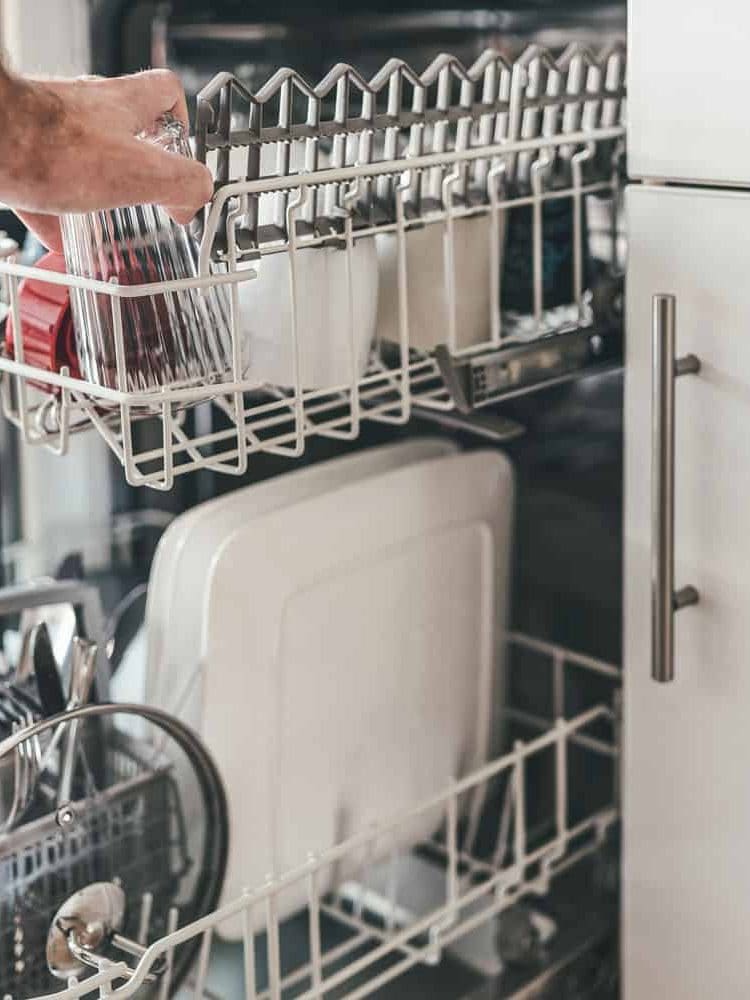
You can also use antifreeze to winterize your dishwasher if you don't want to go through the trouble of draining it. Let's look at how.
1. Drain The Dishwasher & Add Anti-freeze
Start by draining the water from your dishwasher's hose, which is located behind the dishwasher. Next, pour 1/3 to 1/2 a gallon of non-toxic RV anti-freeze into the basin of the dishwasher. Then, power on the dishwasher and select the quickest wash cycle; this will allow the antifreeze to run through all of the water lines and tubing of the dishwasher. Remain in the kitchen as the dishwasher goes through its cycles.
2. Turn it Off Before The Rinse
Stop the dishwasher at the end of the wash cycle (before it starts the rinse cycle). Doing so will allow the antifreeze to remain in the dishwasher's water lines and hoses to prevent them from freezing. It's also helpful to place a sign on the dishwasher to prevent any usage attempts while it is winterized.
3. Rinse Out The Anti-freeze Before Future Use
Once you are ready to operate the dishwasher again, you'll first need to flush out the antifreeze. To do so, turn the dishwasher's water supply back on (ensure that the cold weather has passed and there is no risk of the pipes bursting). Power on the dishwasher and run three or four full wash cycles so that the antifreeze can run through the dishwasher and rinse from the plumbing and tubes.
How Do You Prepare Your Dishwasher For Vacation?
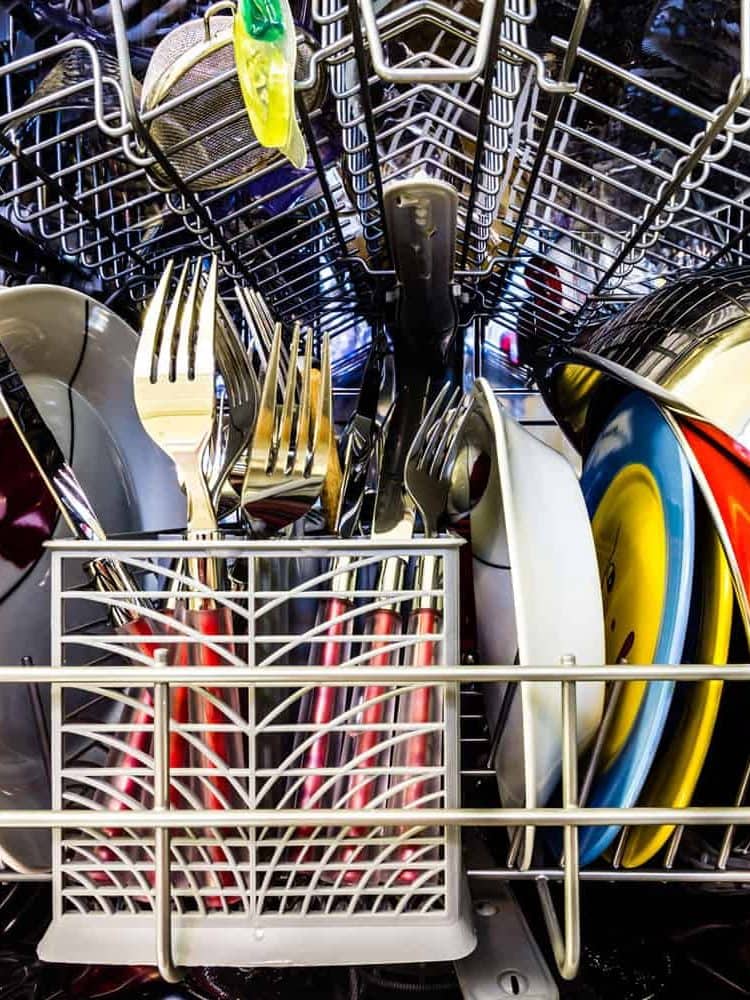
Before going on vacation, you may want to drain your dishwasher. To do so, first, remove all of the dishes from the top and bottom racks as well as any silverware or utensils. Then, take a damp microfiber cloth and wipe down the interior of your dishwasher to remove any food particles, debris, or caked-up grease that may lie on its surface or the dish racks. Lastly, remove the filters of your dishwasher and dispose of any food particles that they may contain. Next, run the filters under warm water to ensure that the mesh is free of clogs.
It may also be a good idea to run a quick empty load on a hot temperature setting to sanitize the dishwasher and ward off any potential mold or bad smells (you can also place a cup of vinegar in the dishwasher beforehand).
Should You Leave Your Dishwasher Open?
There's nothing wrong with leaving your dishwasher open after it completes its wash cycle. Not only can this help to prevent mold and other microbes from forming in a moist environment, but it can also help the dishes to dry faster.
Can You Store A Dishwasher In The Cold?
Generally, electrical appliances should never be stored in temperatures beneath 40 to 50 degrees Fahrenheit, as it can cause their electrical components to malfunction. If the appliance is connected to any water pipe, hoses or pumps, the temperatures can cause them to burst--which may cause your home to flood.
Wrapping Things Up
It's best to winterize your dishwasher if you plan to leave it for an extended period of time in an extremely cold location. You can winterize your dishwasher by draining all of the water from it, or by using antifreeze.

Before you go, be sure to check out our other posts:
How to Clean Oven Door Glass [5 EASY ways]
How to Store Food Processor Blades



![Man's hand taking out a dishwasher filter, Do Amana Dishwashers Have Filters [And How To Clean Them]](https://kitchenseer.com/wp-content/uploads/2021/11/Mans-hand-taking-out-a-dishwasher-filter-Do-Amana-Dishwashers-Have-Filters-And-How-To-Clean-Them-250x250.png)
